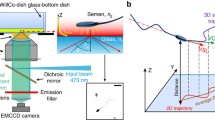Abstract
The fluid dynamics of sperm motility near both rigid and elastic walls is studied using the immersed boundary method. Simulations of both single and interacting organisms are presented. In particular, we find that nearby organisms originally undulating with a 90° phase shift may adjust their relative swimming velocities and phase-lock. Comparisons with previous analytical results are also discussed. The tendency of a near-wall to attract organisms is demonstrated.
Similar content being viewed by others
References
Beyer, R. P. 1992. A computational model of the cochlea using the immersed boundary method.J. Comput. Phys. 98, 145–162.
Brennen, C. and H. Winet. 1977. Fluid mechanics of propulsion by cilia and flagella.Ann. Rev. Fluid Mech. 9, 339–398.
Chorin, A. J. 1968. Numerical solution of the Navier-Stokes equations.Math. Comp. 22, 745.
Dillon, R., L. Fauci and D. Gaver. 1995. A microscale model of microbial transport in porous media. InNumerical Methods for Water Resources. Kluwer Academic Press.
Dresdner, R. D. and D. F. Katz. 1981. Relationships of mammalian sperm motility and morphology to hydrodynamic aspects of cell function.Biol. Reprod. 25, 920–930.
Fauci, L. J. 1990. Interaction of oscillating filaments: a computational study.J. Comput. Phys. 86, 294–313.
Fauci, L. J. 1992. Peristaltic pumping of solid particles.Comp. Fluids 21, 583–598.
Fauci, L. J. 1993. Computational modeling of the swimming of biflagellated algal cells.Contemp. Math. 141, 91–102.
Fauci, L. J. and C. S. Peskin. 1988. A computational model of aquatic animal locomotion.J. Comput. Phys. 77, 85–108.
Fauci, L. J. and A. L. Fogelson. 1993. Truncated Newton methods and the modeling of complex immersed elastic structures.Comm. Pure Appl. Math. 46, 787–818.
Fogelson, A. L. 1984. A mathematical model and numerical method for studying platelet adhesion and aggregation during blood clotting.J. Comput. Phys. 56, 111–134.
Fogelson, A. L. and C. S. Peskin. 1988. A fast numerical method for solving the threedimensional Stokes' equations in the presence of suspended particles.J. Comp. Phys. 79, 50–69.
Gray, J. and G. Hancock. 1955. The propulsion of sea-urchin spermatozoa.J. Exp. Biol. 32, 802–814.
Gueron, S. and N. Liron. 1992. Ciliary motion modeling, and dynamic multicilia interactions.Biophys. J. 63, 1045–1058.
Gueron, S. and N. Liron. 1993. Simulations of three-dimensional ciliary beats and cilia interactions.Biophys. J. 65, 499–507.
Higdon, J. J. L. 1979a. A hydrodynamic analysis of flagellar propulsion.J. Fluid Mech. 90, 685–711.
Higdon, J. J. L. 1979b. The hydrodynamics analysis of flagellar propulsion: helical waves.J. Fluid Mech. 94, 331–351.
Higdon, J. J. L. 1979c. The generation of feeding currents by flagellar motion.J. Fluid Mech. 94, 305–330.
Katz, D. F. 1974. On the propulsion of micro-organisms near solid boundaries.J. Fluid Mech. 64, 33–49.
Katz, D. F. and S. A. Berger. 1980. Flagellar propulsion of human sperm in cervical mucus.Biorheol. 17, 169–175.
Lighthill, J. L. 1976. Flagellar hydrodynamics.SIAM Rev. 18, 161–230.
Pedley, T. J. and J. O. Kessler. 1992. Hydrodynamic phenomena in suspensions of swimming microorganisms.Ann. Rev. Fluid Mech. 24, 313–358.
Peskin, C. S. 1977. Numerical analysis of blood flow in the heart.J. Comp. Phys. 25, 220–252.
Peskin, C. S. and D. M. McQueen. 1989a. A three-dimensional computational model for blood flow in the heart I.J. Comp. Phys. 81, 372–405.
Peskin, C. S. and D. M. McQueen. 1989b. A three-dimensional computational model for blood flow in the heart II.J. Comp. Phys. 82, 289–297.
Phan-Thien, N., T. Tran-Cong and M. Ramia. 1987. A boundary-element analysis of flagellar propulsion.J. Fluid Mech. 184, 533–549.
Pozrikidis, C. 1992.Boundary Integral and Singularity Methods for Linearized Viscous Flow. Cambridge Texts in Applied Mathematics (1992).
Rothschild, L. 1963. Non-random distribution of bull spermatozoa in a drop of sperm suspension.Nature 198, 1221–1222.
Winet, H., G. S. Bernstein and J. Head. 1984. Observations on the response of human spermatozoa to gravity, boundaries and fluid shear.J. Reprod. Fert. 70, 511–523.
Author information
Authors and Affiliations
Rights and permissions
About this article
Cite this article
Fauci, L.J., McDonald, A. Sperm motility in the presence of boundaries. Bltn Mathcal Biology 57, 679–699 (1995). https://doi.org/10.1007/BF02461846
Received:
Accepted:
Issue Date:
DOI: https://doi.org/10.1007/BF02461846




